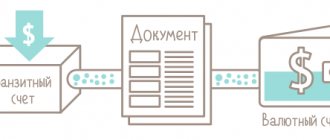Checking account is a phrase often used in banking, accounting and business circles. Usually found in details or a company card and in abbreviated form is more often used as “r/s”. What is a current account, how does it differ from a personal, correspondent or beneficiary account? What advantages does it give to legal entities and individual entrepreneurs? How to open or close it, what documents are required for this? We will tell you about all this and more in our material.
What is a current account in simple words and what is it for?
A current account is a bank account that is opened for legal entities and individual entrepreneurs (hereinafter referred to as individual entrepreneurs) for the purpose of conducting financial transactions: non-cash payments, for example, purchasing goods from a supplier, issuing invoices to other legal entities to pay for your services, accounting and storage of funds.
A current account allows an organization or entrepreneur to:
- Make non-cash payments, for example, for renting premises, transport services, purchasing goods, etc.;
- Issue invoices to other legal entities for payment of their own services;
- Make currency transfers to counterparties from other countries;
- Maintain accounting and storage of funds;
- Conduct collection of funds, followed by crediting to your account and converting cash into non-cash form;
- Receive interest on the balance of funds in the account;
- Use additional banking services, such as overdraft, lending, acquiring, factoring, leasing, bank guarantees;
- Pay employees wages by transferring non-cash funds to bank cards within the framework of the “Salary Project”;
- Participate in tenders on the State Procurement website or take part in auctions for the bankruptcy of legal entities and individuals;
- Pay taxes, contributions to the Pension Fund and Social Insurance Fund.
The current account details are a unique 20-digit set of numbers that allows the bank to identify the client.
By the way, the concept of “current account” is absent in the legislation of the Russian Federation. Information can only be obtained in paragraph 2.3 of the Central Bank Instruction No. 153-I dated May 30, 2014 “On opening and closing bank accounts, deposit accounts, and deposit accounts.”
A current account can be opened by either an individual (in this case the account is called a current account) or a legal entity. Organizations and individual entrepreneurs use it strictly for commercial activities, and the obligation of legal entities to have a current account in Russia is enshrined in law.
For individual entrepreneurs there is no such strict restriction; you can operate without a cash account, but in some cases this will be problematic. More on this below.
Why do you need a current account?
A vehicle can be registered by both a legal entity and an individual. It is used for the following purposes:
- storage of funds – both in national and international currency;
- making money transfers ;
- cashing out money - this can be done at a bank branch; if you want to withdraw a large amount, it is better to call the bank in advance and notify them about this so that they can prepare the required amount of cash;
- payment under contracts and transactions;
- transfer .
If you operate with small amounts, a useful addition would be to link your current account to a debit or credit card - this means that you can carry out money transactions through an ATM without visiting a bank branch.
Current account for individual entrepreneurs
The law does not oblige entrepreneurs to open current accounts. You can use bank accounts and cards opened for an individual. But, as practice shows, it is difficult to run a successful business using them.
There are not so many cases when you can conduct business without using a current account. All of them relate to retail trade and the provision of personal services.
So, for example, if you sell fruits/vegetables at the market and accept payments from customers in cash, then most likely you will not need a current account.
By the way, according to the instructions of the Bank of Russia (clauses 5 and 6 No. 3073-U dated October 7, 2013), cash payments between individual entrepreneurs and legal entities are limited to the amount of 100,000 rubles. under one Agreement. Let's explain this rule with examples.
Example #1: Market Trading
Let's say you pay rent for a place on the market by transferring money to the bank account of the organization that owns the market. The lease agreement is usually concluded for 11 months. If the rental of your place officially under the Agreement is, for example, 20,000 rubles. per month, then the limit is 100,000 rubles. will occur in 5 months. This means that from the sixth to the eleventh month you will need to make the remaining rent payments by bank transfer, that is, without a current account. When you purchase fruits/vegetables from a legal entity under the Agreement, there is also a limit of 100,000 rubles. To avoid this, some entrepreneurs break such contracts into several. True, not all organizations and legal entities willingly agree to this.
Example #2: Manicure services at home
Let's consider another example: a girl opened an individual entrepreneur on Patent and provides manicure/nail extension services at home. Accepts customer payments in cash, does not pay rent, and does not interact with legal entities. In this case, there is no need to open a current account. However, not all clients will be comfortable paying for services in cash. According to the Central Bank, the number of transactions using bank cards in 2017 increased by a third compared to the same period in 2016. In total, there were 24 billion transactions totaling 63.4 trillion rubles.
As Olga Skorobogatova, First Deputy Chairman of the Bank of Russia, stated: “Over the past years, the trend towards increasing the use of bank cards in the payment system for goods and services has been increasing and the number of cash withdrawn from cards has been decreasing.”
In such a situation, to improve the quality of service, it is more advisable for an individual entrepreneur - a manicurist - to have a terminal for accepting card payments. And then, for such a terminal to fully operate, she will need a bank account.
Well, if your activity is tied to working with large enterprises and there are significant sums in circulation, then there is no way without a current account. Even if it is less economically profitable, your potential customers will give preference to those counterparties who have a current account.
You can open several current accounts for different purposes, which allows you to more clearly account for cash flows. To optimize accounting costs, entrepreneurs use remote banking services, gaining the opportunity to automate business processes.
What do the numbers in the current account mean?
Only at first glance, it may seem that the numbers in the current account are selected randomly. In fact, they all have their meaning. It is not at all necessary to memorize, but it is useful to know about the possibility of decoding. For example, you can always check whether the counterparty provides you with reliable information about itself. For clarity, let’s divide a certain account into semantic blocks:
Here:
- 408 — the first three digits indicate who opened the account. For example, 408 – individuals and individual entrepreneurs; from 411 to 419 - government organizations; from 420 to 422 - legal entities and so on.
- 02 – these numbers show the type of activity of the person who opened the account. For example, 40802 is an account opened by an individual who is an individual entrepreneur. 40702 – account opened for a legal entity, open or closed joint stock company.
- 810 - account currency. 810 is the Russian ruble for domestic transfers, 643 is the ruble for international transfers, 840 is the American dollar, 978 is the euro.
- 4 – a check digit by which the bank determines whether the account is recorded correctly and whether it is currently valid.
- 3000 – number of the bank branch in which the account was opened (not to be confused with other details - BIC).
- 0024501 – number of the client who opened the account in this bank division.
A complete list of account digit values can be found in Appendix No. 1 to Bank of Russia Regulations dated February 27, 2017 N 579-P
By the way, in order to completely avoid errors when transferring funds, the bank identification code (BIC) and the bank's correspondent account are indicated in the details along with the current account number.
What operations can be carried out on a current account?
The following actions are allowed on the current account:
1 Account replenishment . If your company provides services using cash, then replenishment is made through a bank cash desk or through an ATM/terminal.
In general, banks are cautious about such operations, and if you try to “pump” millions of banknotes into your account every day in this way, the security service of the credit institution will have questions. They will quite reasonably try to find out how legally these funds were obtained. Therefore, you should carefully save all reports on cash transactions - with large turnovers, the bank may request it.
2 Withdrawal of cash from the account. Banks are also not very fond of such operations: draconian commissions are often established for large withdrawals. As a rule, it is possible to systematically withdraw significant funds only through the bank’s cash desk.
3 Transfers to legal entities and individual entrepreneurs. Payment for supplies, services provided, work performed - to carry out such settlements with counterparties, it is necessary to create a payment order. You can issue a payment order in an accounting program, for example 1C, print it out and bring it to the bank. But this method is more expensive and is rarely used by entrepreneurs. Most modern banks that provide settlement and cash services allow you to create payment documents remotely (from home or office), which is much more convenient and faster than running around bank branches and standing in queues.
4 Mandatory payments to the Tax Service, Pension Fund and Social Insurance Fund. The online services of many banks allow you to generate payments to government agencies. They usually do not charge a commission for the transfer.
5 Transfers to individuals. If you are an individual entrepreneur without employees, then using this type of payment you can transfer the money you earn to a card issued to you as an individual. In most banks, this is cheaper than cashing out money at the cash desk. Just don’t try to get involved in adventures with cashing out funds - the account will be blocked instantly.
6 Receiving non-cash payments from individuals and legal entities. Funds to the account come from payments made through the bank's cash desk, acquiring POS terminals and from regular payments made using payment documents.
What documents are needed to open an account?
| Type of documents | Entity | IP |
| Documents required to be provided | Charter of LLC, CJSC, PJSC, NJSC | Passport of a citizen of the Russian Federation or other identity document of an individual entrepreneur:
|
| Certificate of registration of a legal entity, extract from the Unified State Register of Legal Entities, received no earlier than one month in advance | Application in the prescribed form (filled out at the bank) | |
| Certificate of registration issued by the tax office before 01/01/2017 (if available) | ||
| A document confirming the authority of the manager (appointment order, minutes of the meeting of shareholders, participants, decision or other documents) | Card with sample signature of the entrepreneur (to be filled out at the bank) | |
| Order/power of attorney, if the director delegates to an employee the right to dispose of the organization’s non-cash funds | Certificate of registration of an individual entrepreneur or a sheet of the Unified State Register of Entrepreneurs on registration of an individual entrepreneur | |
| A sheet from the statistics department with the organization’s activity codes | Tax reporting for the last period (if the activity has been carried out for more than 3 months) | |
| Sample signatures and seals certified by a bank specialist or notarized | ||
| Licenses and permits, if the type of activity of the organization requires it | ||
| Power of attorney if the documents are not submitted by the head of the organization. | ||
| Sheet of information about the beneficiaries of the company | ||
| Documents that the bank may require additionally) | Confirmation of the real existence of a legal address (document of ownership of the premises or lease agreement). | It may be necessary to provide information about the main counterparties (including prospective ones if the activity is just starting) - these are the requirements in some territorial branches of Sberbank |
| Certificate of business reputation (letter of recommendation from one or two counterparties) | ||
| Confirmation of financial solvency (accounting statements, tax return, certificate of absence of overdue debts) | ||
To open a settlement (current) account, an individual simply needs to present a passport and sign an application that will be generated by the operator.
If an organization or individual entrepreneur provides false information about themselves, they may be refused to open a current account. Refusal may occur in other cases, and the bank is not obliged to explain the reasons.
How to open a current bank account
An individual wishing to open a current bank account must submit to the bank a set of documentation, which includes (clause 3.1 of instruction No. 153-I):
- Citizen's identity document.
- Card with sample signatures. Usually this document is drawn up directly at the bank immediately when opening an account in the presence of a responsible bank employee, but it is also possible to present a card certified by a notary. In this case, a card in which all signatures are certified by one notary is considered proper (clause 7.9 of instructions No. 153-I).
- Documents confirming the authority of the persons indicated in the card to dispose of funds in a current bank account - this requirement is relevant if the authority to dispose of these funds is transferred by the account owner to third parties. Verification of the powers of such persons is carried out by the bank according to the regulations established by banking rules and the agreement with the client (clause 2 of the resolution of the Plenum of the Supreme Arbitration Court of the Russian Federation dated April 19, 1999 No. 5, hereinafter referred to as PVAS No. 5).
- TIN certificate of the individual (if available).
If a foreign citizen or stateless person is going to open a current account, then the following must also be attached to the documents listed above:
- migration card;
- a document confirming the right of such a person to reside on the territory of the Russian Federation, if the submission of such documents is provided for by law.
In addition, when opening a current account, an individual also fills out a special questionnaire on the bank’s form and grants/does not grant the bank the right to receive, store and process personal data (Clause 1, Article 6 of the Law “On Personal Data” dated July 27, 2006 No. 152- Federal Law).
One individual can open several current bank accounts.
How to open a current account
The algorithm for opening an account is approximately the same for both legal entities and individual entrepreneurs.
Step 1. Selecting a bank
When choosing a bank to open a current account, we recommend adhering to the following criteria:
1 Your company's needs. You need to make a list of the services you need and determine which of them are most important (for a regular store - inexpensive collection, for an online store - speed of online payments, and so on).
2 Tariff plan. Study the packages offered by several banks. Considering that marketing promotions are a way to lure a client, you should not rush to the first offer to open a free account. Look at the cost of other services: monthly maintenance, commission for payment orders. Inexpensive collection may well be combined, for example, with a huge commission for withdrawing funds to the accounts of individuals - such a tariff plan will not be profitable to use for paying salaries to staff. The best thing to do is to make a table, in one column of which there will be the services you need, and in the other - the amount that this or that bank will charge. By comparing the final data you can easily make your choice. An example of the design of such a table with data from real banks can be found here.
3 Reviews from other users. Monitor reviews on the Internet about the bank you are interested in. If there is a lot of negativity about the chosen bank, then perhaps you should not rush to make a choice.
4 Where your key counterparties and partners are served. If your counterparties have current accounts in the same bank, then it makes sense to open a current account in the same bank. Your transactions will be processed faster.
5 Mode of bank branches and bank operating day.
6 Number and location of service offices, ATMs. How convenient is it to get to the bank’s office, how many ATMs and branches does it have around the city?
7 Bonuses. Does the bank offer bonuses for loyalty and long-term cooperation (loans at a preferential rate, other services at a reduced cost, and so on).
8 Quality of technical support.
For example, clients at Tinkoff Bank, Alfa Bank, Sberbank have the opportunity to get advice from a bank specialist by calling the hotline or writing to chat, which is sometimes more convenient, for example, when you do not have the opportunity to conduct a dialogue by phone, you are traveling to subway or at the same time doing some important work. And there are Sovdepov banks that provide support only by email and respond only to official requests submitted through the secretary. You can wait several days for answers from them, which is inconvenient in our time of rapid technological progress.
We have a detailed guide on how to choose a profitable bank for individual entrepreneurs. There you will also find an overview and comparison of tariffs, a description of the pitfalls that you may encounter during your work, as well as advice from personal experience. The article was written by an experienced entrepreneur. Read here: Which bank is better to open a current account for an individual entrepreneur? Choosing the best bank for entrepreneurs.
Step 2. Collection and execution of documents
Above, in the corresponding chapter, there is a list of documents that banks require or may request in addition to the main ones. It is better to prepare both of them.
Step 3. Submitting documents to the bank, filling out an application
In many banks, having submitted an online application, an entrepreneur immediately receives details, which allows him to instantly issue invoices to counterparties for payment for services provided. The only restriction: you cannot withdraw money received and make transfers to other organizations until an agreement with the bank has been concluded. Currently, it can be concluded either in the office of a financial institution or at a meeting with its representative. A bank specialist with a set of necessary documents for concluding an agreement can come to your office or home. This service is provided by Tinkoff Bank, Alfa-Bank, Tochka, Modulbank, Sberbank*
* – in some regions only in the office; To clarify this point, go to the Sber website and select your region. If you see the icon “We’ll open an account in your office” in the list of services, it means it’s available to you).
To conclude a formal contract, you will need the originals of all the documents listed above.
Step 4. Signing the contract
After the security service checks your documents, you or your representative will be invited to sign a cash settlement service agreement (CSA), or, as mentioned above, a bank representative will come to you. At the same time, cards with samples of the signature and seal of the organization will be issued (for an individual entrepreneur working without a seal, only signatures).
In some banks, issuing a card with signature samples is a paid service. These samples are needed in the event that if suddenly you do not have the opportunity to transfer payment documents through your personal account on the bank’s website, you will need to close the account or need to visit a bank branch to draw up any other documents.
The forms of agreements in different banks may differ, but in general they are standard. The range of RKO services and their cost are individual. According to the agreement, the bank undertakes to open a current account and provide a range of services to maintain it.
The contract is valid for one year (most often with the possibility of automatic extension).
Step 5. Getting started
After signing the agreement, your current account is ready for use. Along with the package of documents, you will be given access to the online bank and all the necessary instructions for using it. Some banks require a USB Token for online banking to work correctly. This is a special key on a flash drive with which secure transactions are made (payments, transfers, etc.).
If you choose a bank that will work with a token, then keep in mind that this may cause additional inconvenience for freelance entrepreneurs who have entered into a cash settlement agreement in one city, but operate in another city, we wrote more about this in the article on choice current account for individual entrepreneurs.
It is mandatory to inform the bank about all changes in constituent documents, details, legal and actual addresses.
There is no need to inform the tax office about opening an account now - the bank will do it for you.
Deposit account and current account in Sberbank for individuals
Sberbank has been operating for many years. Due to this circumstance, the population associates it with reliability. Most citizens bring money to this credit institution, which is placed on deposit. Among the offers from the country's leading bank related to placing money on deposit are:
- “Save”: replenishment - no, withdrawal - no, closing early - possible. Rate – 9% (rubles), 2.22% (dollars), 1.7% (euros).
- “Save online”, “Save pension”. Online is opened only through Sberbank online, and the second type of deposit is offered only to retired persons.
- “Replenish”: replenishment - yes, withdrawal - no, closing early - possible. Rate – 8% (rubles), 2.00% (dollars), 1.01% (euros).
The remaining deposits from Sberbank are designed for the possibility of partial withdrawal of funds. These include contributions:
- "Manage";
- "Multi-currency";
- “International”, etc.
Separately, Sberbank offers deposits for pensioners.
New bill
The inflow and outflow of funds on deposit are usually reflected in the Sberbank savings book. Recently, their issuance has sharply decreased; instead they are offered Sberbank Maestro cards. There were persistent rumors that Passbooks would be abolished. And these rumors received a real basis in February 2020. The Russian government has submitted a bill to the lower house of parliament that would abolish the bearer savings certificate and the savings book.
Authors of the bill
The authors of the project are implementing their idea, according to them, as part of improving Russian laws in the field of non-cash payments and taking measures to counter the legalization of illegally obtained profits. And also within the framework of combating the financing of terrorism.
The Ministry of Finance believes that these measures will be implemented only when savings certificates and bearer books are excluded from circulation. What will happen to registered savings books remains unclear.
Meanwhile, many consumers of banking services prefer savings books with a deposit account to the constantly imposed plastic cards. Most of these citizens are people of retirement age who find it difficult to understand a plastic card and the mechanism for withdrawing money from it. For them, the savings book has become a symbol of their income, which is in the bank.
At the same time, another category of the population, young people, prefer plastic cards. They are being implemented everywhere by all banks without exception, offering credit products or issuing a card as a debit card. And there are some subtleties here, but they relate to the topic of loan products from banks.
Bank deposit insurance program
We notify the tax authorities about opening an account in a foreign bank and report
Related Posts
How much does it cost to open an account?
In itself, the cost of opening an account without prices for other operations within the framework of cash management services says little, but it happens that this is a fundamental issue. Here's what leading Russian banks offer:
| Bank | Cost of opening and maintaining an account |
| Sberbank | Free (minimum balance – 10 rubles) |
| Tinkoff | From 0 to 1000 rubles (when opening an account at a bank office) |
| Alfa Bank | From 0 rubles (minimum balance – from 1 ruble). |
| LokoBank | From 0 to 1300 rubles |
| UBRD | From 0 rubles |
| Dot | From 0 rubles |
| ExpertBank | From 0 rubles |
How to close a current account
The account can be closed at the initiative of both the bank and the client himself. Let's look at the first option first.
The bank may block and then close your current account if:
- The client's account has a zero balance for 2 years.
- There have been no transactions on the account for 2 years.
- The bank found signs of violation of Federal Law No. 115-FZ (“On combating the legalization (laundering) of proceeds from crime and the financing of terrorism”). The account is closed if, on the basis of this Federal Law, incoming and/or outgoing transactions were blocked twice during the year.
For the first two reasons, the bank must notify the client of the upcoming closure of the account 2 months in advance by registered mail. On the third basis, the bank may terminate the cash settlement agreement without warning.
If you decide to close your account yourself, you must do the following:
- Submit an application to the bank to close the account and terminate the cash settlement agreement.
- If any bank services remain unpaid, pay off these debts.
- Hand over your checkbook and plastic cards (if issued) to the bank.
- Withdraw to another account or receive cash balances from the account being closed.
- Obtain a certificate from the bank confirming the closure of the account.
By law, the procedure takes no more than 7 days. To speed things up, withdraw the maximum possible amount of funds from the account in advance, leaving only to pay commissions, if any (usually the bank closes the account for free, but small credit institutions may set other conditions).
Another option is to close the account in the event of bankruptcy of the company; in this case, everything is handled by the bankruptcy trustee.
On the topic of bankruptcy
Closing a current account at the initiative of a bank or an authorized body
In this case, the grounds for closing a current bank account are:
- issuance of 2 or more decisions within 1 calendar year to refuse to execute the account owner’s orders to carry out transactions due to the presence of reasons to believe that a particular operation may be associated with the laundering of illegal proceeds or support of terrorist organizations (paragraph 2, clause 5.2 of Art. 7 of the Law “On Countering ...” dated 08/07/2001 No. 115-FZ);
- absence of money and transactions on the account for 2 years (clause 2 of Article 859 of the Civil Code of the Russian Federation);
- issuance of a corresponding act by a judicial authority (clause 4 of Article 859 of the Civil Code of the Russian Federation);
- failure by the client to provide appropriate information when changing his identification characteristics (see Resolution of the Presidium of the Supreme Arbitration Court of the Russian Federation dated April 27, 2010 No. 1307/10).
You may also be interested in the article on the ConsultantPlus website “Tax blocking of current accounts of entrepreneurs: is there a chance to turn the situation around?” If you do not yet have access to the ConsultantPlus system, you can obtain it free of charge for 2 days.
FAQ
Registered LLC. How long does it take to open a current account?
According to Russian legislation, the founder of an LLC decides when to open a current account; no deadlines have been established. It is logical to do this simultaneously with the start of operating activities. If you receive cash from customers, you need to collect it to avoid problems with the tax office. By the time your counterparties transfer funds by bank transfer, you must have a current account number.
Can a bank refuse to open a current account?
Article 846 of the Civil Code of the Russian Federation does not give the bank the right to refuse to conclude an agreement to open an account with a client, except in cases where this cannot be done for internal reasons (for example, a credit institution is in bankruptcy or does not work with individual entrepreneurs, and this is enshrined in the relevant documents). If this requirement is violated, take a letter from the bank explaining why you were denied (Instruction of the Central Bank of the Russian Federation No. 4760-U dated March 30, 2018). With this document, you should contact the online reception on the Bank of Russia website (cbr.ru) or submit an application by mail, attaching the documents that you previously sent to the bank. Your application must be reviewed within 20 days. If a decision is made in your favor, the Central Bank of the Russian Federation will force the bank to enter into an agreement with you (previously it was necessary to go to court, starting in 2020, the procedure for handling complaints has been simplified). Just think first: do you need a bank that doesn’t want to see you as a client?
How many current accounts can one organization have? Is it allowed to have accounts in different banks?
According to Article 30 of Federal Law No. 395-1 of December 2, 1990 “On Banks and Banking Activities,” clients have the right to open the number of current accounts they need in any currency in any banks of the Russian Federation (with the exception of restrictions established for state and some other organizations).
Some company mistakenly transferred money to our bank account. Doesn't require back. What to do in this case?
According to the general rules established by banks for current accounts, if an erroneous crediting of funds is detected, it is necessary to notify the bank about this no later than 10 days later. You cannot misappropriate other people's money - this can be considered theft with all the ensuing consequences.
Are the current account and the beneficiary's account the same thing?
The payee's account is the same as a current account if we are talking about individual entrepreneurs working using a bank card issued to an individual entrepreneur. This account (formally it is ordinary, 20-digit) can be used both for settlements and for storing funds. Legal entities open such accounts to receive payment for services provided to a wide range of people.
How does a current account differ from a correspondent account?
If a current account is opened by a legal entity and an individual entrepreneur, then a correspondent account is opened by one bank for another. Interaction between banks is carried out on the basis of a correspondent agreement. Commercial banks, the Central Bank of the Russian Federation, and clearing companies can act as parties. If you, as an individual entrepreneur or LLC, instruct your bank to transfer money from your current account to a counterparty to an account in another bank, it is for a reason that you are required to provide details in which, along with the addressee’s current account, a correspondent account is also indicated. The transfer is sent specifically to a correspondent account in another bank, and from there it goes to the counterparty’s current account. This method allows you to keep track of and control the movement of funds between credit institutions, and also allows banks to use the settlement system of the Central Bank or larger commercial banks.
There are several types of correspondent accounts, depending on the purpose:
- the bank opens correspondent accounts with other banks to carry out debit transactions of clients to pay for services;
- the bank opens its correspondent accounts in other banks;
- A Russian bank opens a correspondent account for a foreign bank.
The first two types of correspondent accounts are often used, the third - rarely.
What is the difference between a personal account and a current account?
It all depends on the context in which the concept of a personal account is mentioned. Their main task is to identify a particular client in the bank. For convenience, it is customary to call a current account a bank account opened for an individual entrepreneur or a legal entity, and a personal account is a bank account opened for an individual.
The screenshot below shows the bank details of an individual who has issued a regular debit card at Sberbank to receive child benefits.
As we can see, a 20-digit account is no different from the account assigned to an entrepreneur or some kind of LLC. In addition to the account, the BIC, correspondent account and other details are indicated.
An individual can perform all the same operations as a legal entity: transfer money to another person or organization, pay for goods and services, withdraw cash from your account, etc.
But if the concept of a personal account is mentioned in connection with any organization, then the context will be different. For example, when we enter into an Agreement for the provision of mobile communication services, a personal account is opened in our name with the mobile operator, into which all our funds will be transferred to pay for the services used.
The essence is the same as in banks - identification of a specific client, so that the operator’s accounting department understands in whose name the received funds should be credited.
Master account
The master account is related to the current account, but it is opened on the basis of a complex agreement.
The agreement includes the opening of three current accounts - in national currency, dollars and euros.
In addition, a card is issued. This means that you can use online banking services in your personal account. You can also link existing cards and credit cards to it and issue new ones.
✅ RECOMMENDED: What is the payee's account and how can I find out its number?
Such an agreement can only be concluded if you do not plan to use it to conduct business and entrepreneurial activities. The service of opening a master account for individuals is free.











